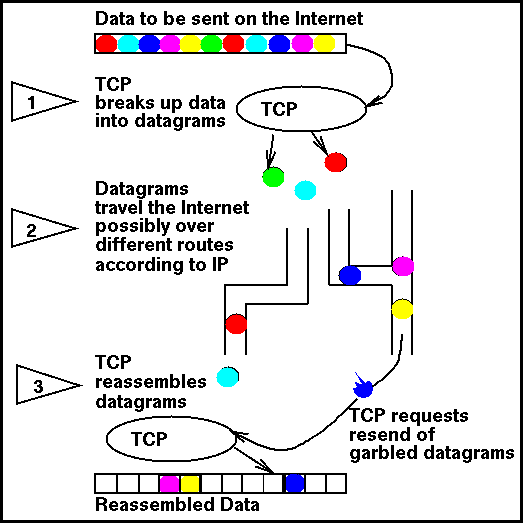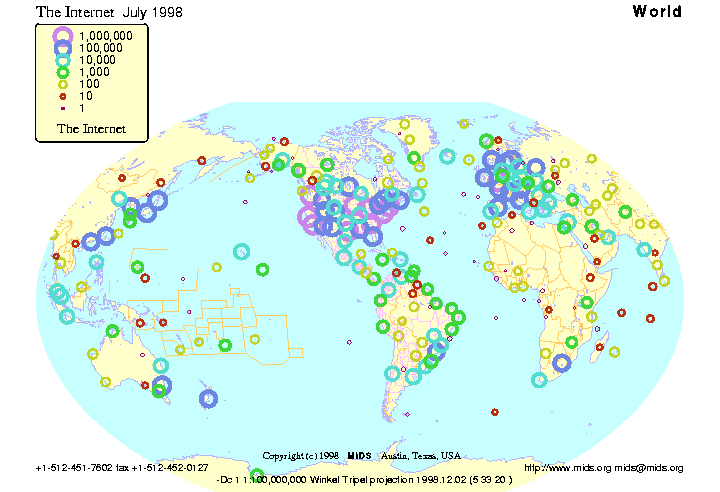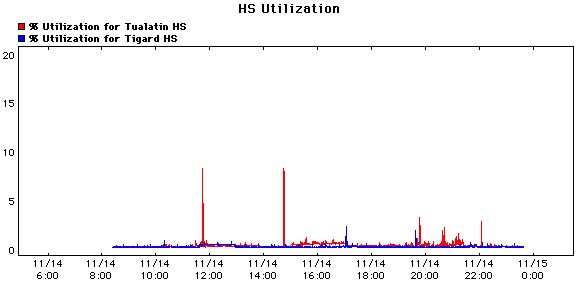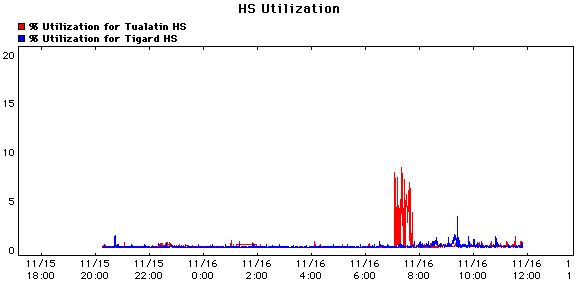


Measuring the bandwhich of the ttsd network.
I) Introduction: Table of Contents
The Internet, is growing bigger and bigger every day, yetís according to some people itís still too small and unorganized. Yet itís size has been increasing drastically over the last couple of years. Itís a good thing that the same rate of increase doesnít apply to pollution, or human population increase, because we would all be dead by now. According to Dave Kristula, it has had an increase of 1500% over the last 5 years, so approximatively an increase of 300% per year. Earth would be an empty, desolated rock my now, if that would have happened. I decided to measure the use of the bandwhich at Tualatin High. If my predictions reveals to be truthful the highest use should be during both the midday period and the end of school time. But letís first of all explain what is hte Internet, when was it created and how does it works.
II) Background Information: Table of Contents
a) Internet History: Table of Contents
I am going to ask you to strech your brains a little and to go back to 42 years ago, to 1957. That year, will be marked by 2 greats event and will be remembered for a long time. At first the Soviet Union launched the first artificial earth sattelite. Well the United States, in the middle of the Cold War were not going to leave it to that, so to fight back space invasion, the Advanced Research project Agency (commonly known as Arpa) is created within the Department of defense . Itís main goal was to establish US lead in sicence and technology, applicable to the military.. This was the backbone of the Internet, five years later, in 1962, Paul Baran, was commisoned by the U.S. Air Force to do a study on how it could maintain its command and control over itís missile and bomber after a Nuclear attack. This was to be a military reasearch network that could survive a nuclear strike, decentralized so that if any locations (cities) in the U.S. were attacked, the military could still have control of nuclear arms for a counter attack. Baran finished his document describing several ways to accomplish that. His final proposal, was a packet switched network. "Packet switching is the breakdown of data into datagrams or packets that are labelled to indicate the origin and the destination of the information an the forwarding of these packets from one computer to another computer until the information arrives at its final destination computer. If packets are lost at any given point, the message can be resent by the originator." The Baran docuament and especially the paragraph cited above, was to be the basis of any computer network, either being a mac, using the appletalk protocol, or a PC using either IPX, Netbui, or TCP/IP (the main protocol used today with the internet). I know this is not easy to visualize, this is why you will find included on the next following page, a timetable more simpler to follow. I am just asking you to bear with me a little longer, we are just getting started.... Well 6 years later, in 1968 to be precise, the Arpanet contract was awarded to BBN (which is where I got that nice timeline you can look at) The physical network was built in 1969, linking 4 nodes: University of California (in Los Angeles, the city of death) , SRI (in Stanford, the mean people), Santa Barbara, and the University of Utah. Everything was linked with a 50 kpbs circuits, we now use 56 kpbs modems.... In 1973, the TCP/IP protocol was developped. There were at that time more than 23 hosts connected to the 50 kpbs backbones, please compare it to the map of hosts in the world today (p ). You didnít thought I was going to leave the creation of the first mail program did you? Well next time donít breathe too early... .That was in 1972. Then the term Internet, was first used by Vinf Cerf and Bob Kahn (I am sure one of those guy is me in one of my past / parallel lifes), that was in 1974. Nine years later, on the 1st January 1983, every single computer connected to the Arpanet network had to use the TCP/IP protocol, it replaced entirely the NCP. DNS (Domain Name System) was also created during that year. This made it so much easier for normal people to access other servers, because they no longer had to remember those 12 digits numbers... Dammit I liked it better the way before, there were only nerds.. Anyway , 1992 is also an important year for that Internet Society was chartered and Cern realeased the World Wide Web. Addtionally the backbones were upgraded to T3ís, which is the equivalent of 44.736 Mbps. By that year there were 1,136,000 hosts. 2 years later, the most important creation since paper, was the possibilty to order Pizzaís on Pizza Hut web site. Now that was really a major change. There is now currently more than 30 000 000 hosts on the Internet.
b) Internet Timeline: Table of Contents



c) What is the Internet? Table of Contents
Now wake up, dammit I said Wake Up, not back to sleep.... The next part is even more fun than the first one, the following pages are going to assess how the Internet is working...
One might ask what is the internet and how do people use it. You often
read about the internet as:
d) The Internet Protocols: Table of Contents
In order to define the Internet, you first need to aggree on what compose the Internet. Some people might argue about the following: NSFNET, CIX, Prodigy, Fido Net, your company internal network. Well letís start by discussing some place almost everyone would agree is on the Internet. Letísm take the TTSD network for example. Theorically you could say that the whole network is on the Internet using the TCP/IP network. But more specifically a computer is considered to be on the Internet, if you can connect from anywhere in the world to that machine using one of the following: WWW, Gopher, FTP, Telnet, Mail... One definition is a network of computers based on the TCP?IP protocol. This protocol is required when you want to connect on the Internet. You might ask, how does it work? Well it breaks up data into datagrams, or packets, then send them to the destination, but they are travelling differentt routes, then the TCP?IP protocol reassembles all the data on the destionation computer.

e) Hosts on the Internet: Table of Contents

III) Data Collected: Table of Contents
a) data chart: click here
B) graphs: Table of Contents

The chart above represent the use of the Bandwidht in the TTSD network, for January 19th 1999.

This chart represent the use of the bandwidth by both High schools in the Tigard-Tualatin School District fort the January 17th 1999.
IV) Data Analysis: Table of Contents
Being passioned by Computers, I decided to realize an experiment for my physics research project that would have to involve it. My first ideas were to compare the speed of different operating systems, but this would have required installing differente OS on the same machine over and over again. So then I decided to research something involving the Internet, and what more interesting than having a look at the bandwhich that Tualaitin High School is using. I wanted to make a program, but I didnít have the skills to realize it. Therefore I decided to use 3 different kinds of data I would measure separatively: at first a ping to 4 different computers, from France98 (198.236.134.180), to:
As a result of this experiment/research, I was able to find that inside our school network, we don't suffer of any loss whatsoever, the data is recieved to a 100% ratio, while when going out to yahoo for example we can suffer a loss of up to 4%, and the farther you go the more this loss will increase. When trying to ping to an host which is located in France, a lost of up to 15% occured. (Mr Murray: Well You know those French Connections....)
Additonally the farther you go geographically, the more time it takes for the packet or datagrams to go to the host and come back. This is logical, for it has to cover more distance, even so the difference will be minimal cause the speed is immense. At last I was able to certiy my assumptions for that the bandwidht is more used on Mondays than any other day of the week. Strangely enough I got more than 20% peak use of bandwidht on Tuesday monrning around 3:00 am, This is much higher than usual for that during the night the use of bandwidht doesn't pass 5% ususally and even during the day it is rare when it is bigger than 15%. There are 3 peaks of bandwidht during a normal day... the first one around 8:00 am, then at noon, and finally between 3 and 4 pm.
V) Bibliography and Links: Table of Contents
The Internet Web Text: World Wide Web http://www.december/com/web/text/webwhat.html
The Media of Internet: http://www.december.com/web/text/hyper.html
The Web's Technology: http://www.december.com/web/text/webtext.html
What is the Internet Anyway: http://www.mids.org/what.html
Internet Timeline: http://www.bbn.com/timeline
The History of the Internet: http://www.davesite.com/webstation/net-history.shtml
FYI on "what is the Internet" ftp://nic.meric.edu/documents/fyi/fyi20.txt
Internet, ENcyclopedia Online: http://www.eb.com